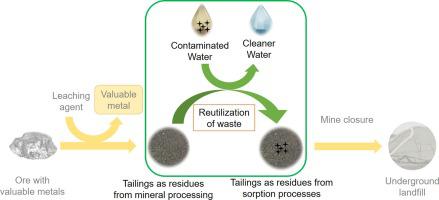Minerals Engineering ( IF 4.9 ) Pub Date : 2021-06-19 , DOI: 10.1016/j.mineng.2021.107019 Sheyla Chero-Osorio , Diana M. Chavez , Alexandra Vega , Almendra Morales , Carlos Gamarra , Juan Carlos F. Rodriguez-Reyes

|
Sustainable schemes favor the reutilization of waste over direct disposal. In the case of mine waste from mineral processing (tailings), the reutilization of such waste as sorbents of contaminants in water can be advantageous, considering that tailings have already a plan for disposal. In this article, a methodology to evaluate the convenience of using residual minerals as sorbents is presented. The sorption ability of pyrite-based tailings using synthetic solutions containing copper ions (Cu+2) is followed and contrasted to the sorption ability of minerals before processing (feed). In the case of as-received samples, tailings show a higher capacity for copper removal in batch tests (1.3 vs. 0.4 mg Cu/g for tailings and feed, respectively). This large difference is associated with (a) the smaller particle size distribution for tailings, and (b) the ability of tailings to increase the pH and favor precipitation of metals. Interestingly, tailings were found also to release smaller amounts of undesired elements such as arsenic and cadmium. Tests using defined particle sizes for feed and tailings demonstrate that copper removal was around 0.45 mg Cu/g in batch experiments and 0.68 mg Cu/g in recirculation experiments. In all cases, copper sorption follows pseudo-second-order kinetics, suggesting a mechanism where copper is chemisorbed, forming copper sulfides according to X-ray photoelectron spectroscopy (XPS) measurements. More importantly, sorption experiments were complemented with simultaneous measurements of metal ion release from the minerals into solution. The metals released during batch sorption are mainly Pb and Zn, in the respective amounts of 0.79 and 0.32 mg/g (feed) and 0.75 and 2.19 mg/g (tailing). Thus, even though the use of mineral residues as sorbents is possible, the metal release should be considered to determine the overall convenience of the process.
中文翻译:

富黄铁矿碱浸尾矿作为吸附剂的再利用必须考虑吸附和解吸的相互作用
可持续计划有利于废物的再利用而不是直接处置。对于矿物加工产生的矿山废物(尾矿),考虑到尾矿已经制定了处置计划,将此类废物作为水中污染物的吸附剂再利用可能是有利的。在本文中,介绍了一种评估使用残留矿物质作为吸附剂的便利性的方法。使用含铜离子 (Cu +2) 被跟踪并与加工前矿物质的吸附能力形成对比(进料)。在接收样品的情况下,尾矿在批次测试中显示出更高的铜去除能力(尾矿和进料分别为 1.3 和 0.4 mg Cu/g)。这种巨大的差异与 (a) 尾矿的较小粒度分布以及 (b) 尾矿提高 pH 值和促进金属沉淀的能力有关。有趣的是,尾矿也被发现会释放出少量不需要的元素,如砷和镉。对进料和尾矿使用规定粒径的测试表明,在批量实验中铜去除率约为 0.45 mg Cu/g,在再循环实验中约为 0.68 mg Cu/g。在所有情况下,铜吸附遵循伪二级动力学,表明铜被化学吸附的机制,根据 X 射线光电子能谱 (XPS) 测量形成硫化铜。更重要的是,吸附实验与金属离子从矿物释放到溶液中的同步测量相辅相成。批量吸附过程中释放的金属主要是铅和锌,分别为 0.79 和 0.32 毫克/克(进料)和 0.75 和 2.19 毫克/克(尾矿)。因此,即使使用矿物残留物作为吸附剂是可能的,也应考虑金属释放以确定该过程的整体便利性。分别为 0.79 和 0.32 毫克/克(进料)和 0.75 和 2.19 毫克/克(拖尾)。因此,即使使用矿物残留物作为吸附剂是可能的,也应考虑金属释放以确定该过程的整体便利性。分别为 0.79 和 0.32 毫克/克(进料)和 0.75 和 2.19 毫克/克(拖尾)。因此,即使使用矿物残留物作为吸附剂是可能的,也应考虑金属释放以确定该过程的整体便利性。











































 京公网安备 11010802027423号
京公网安备 11010802027423号